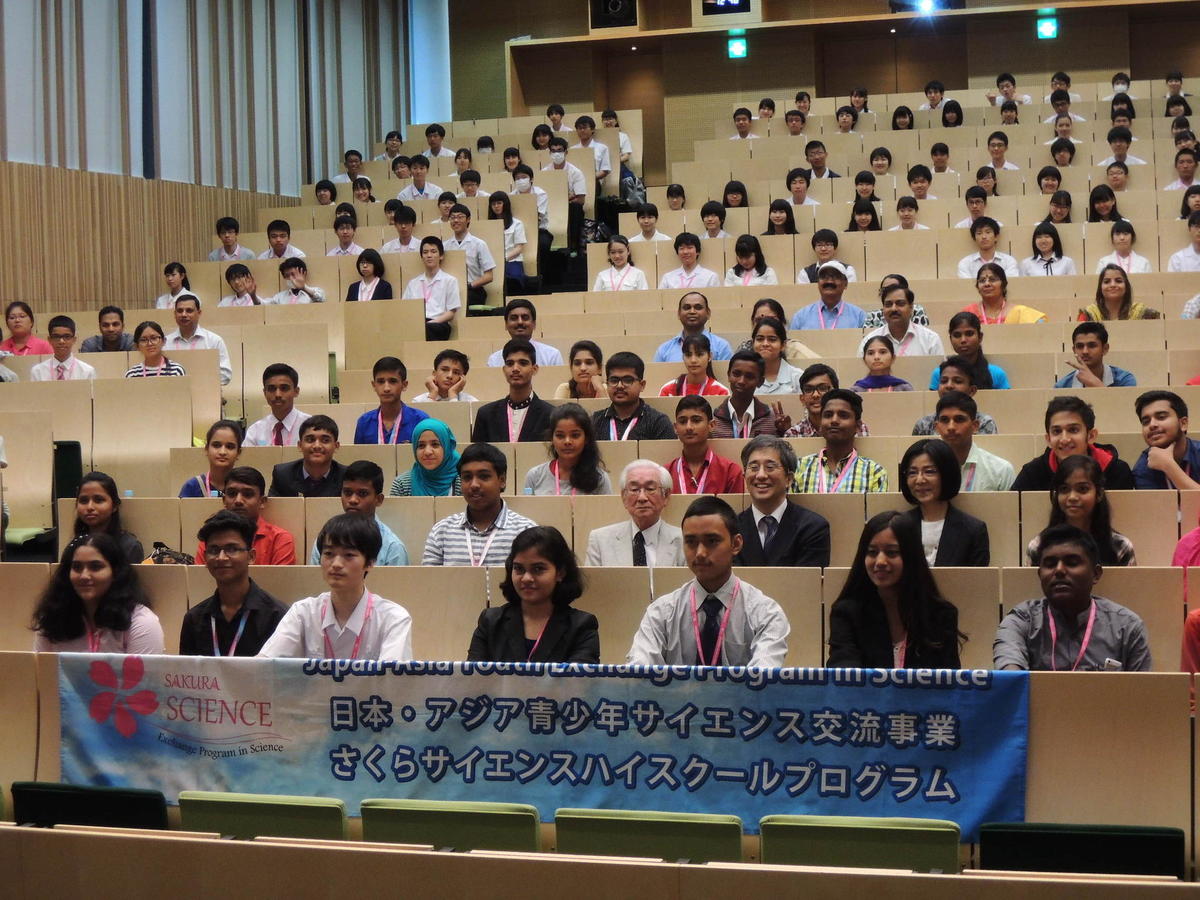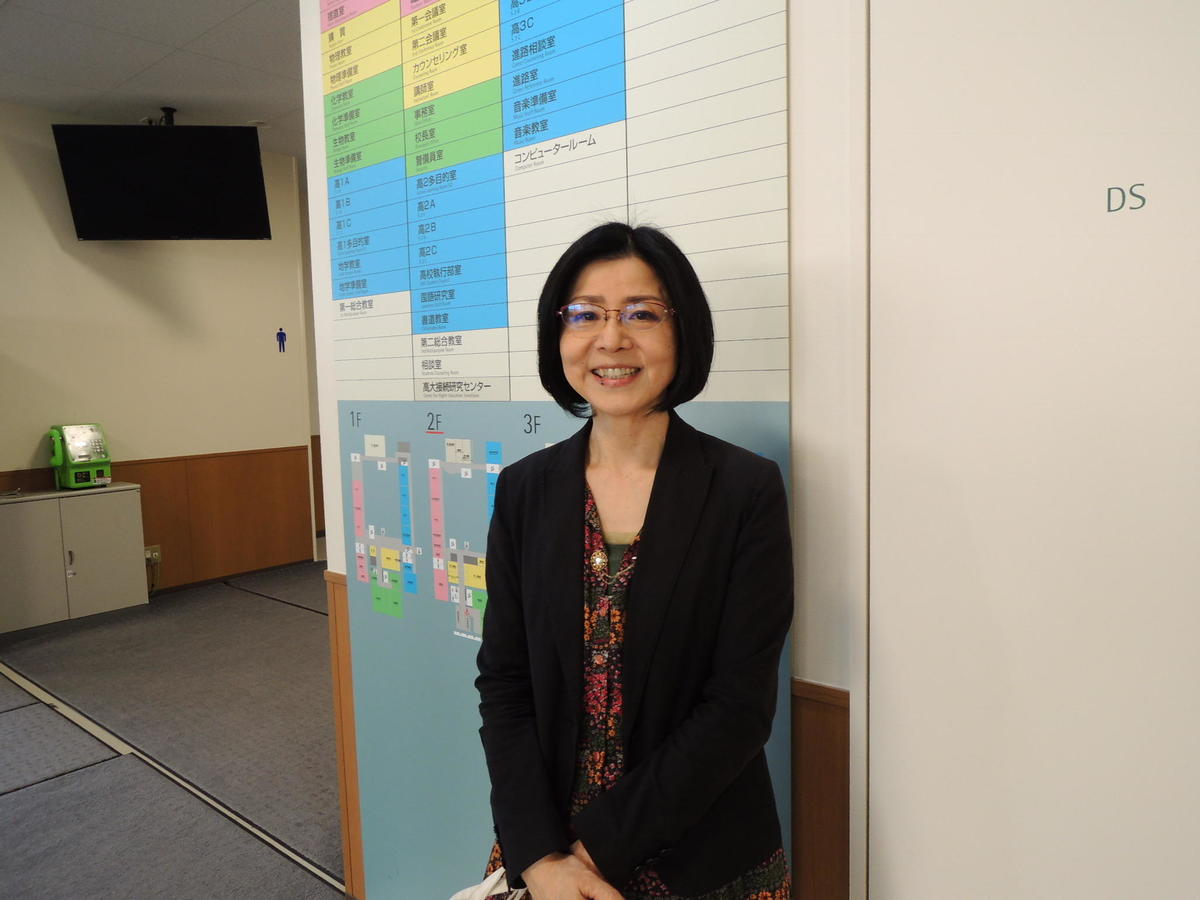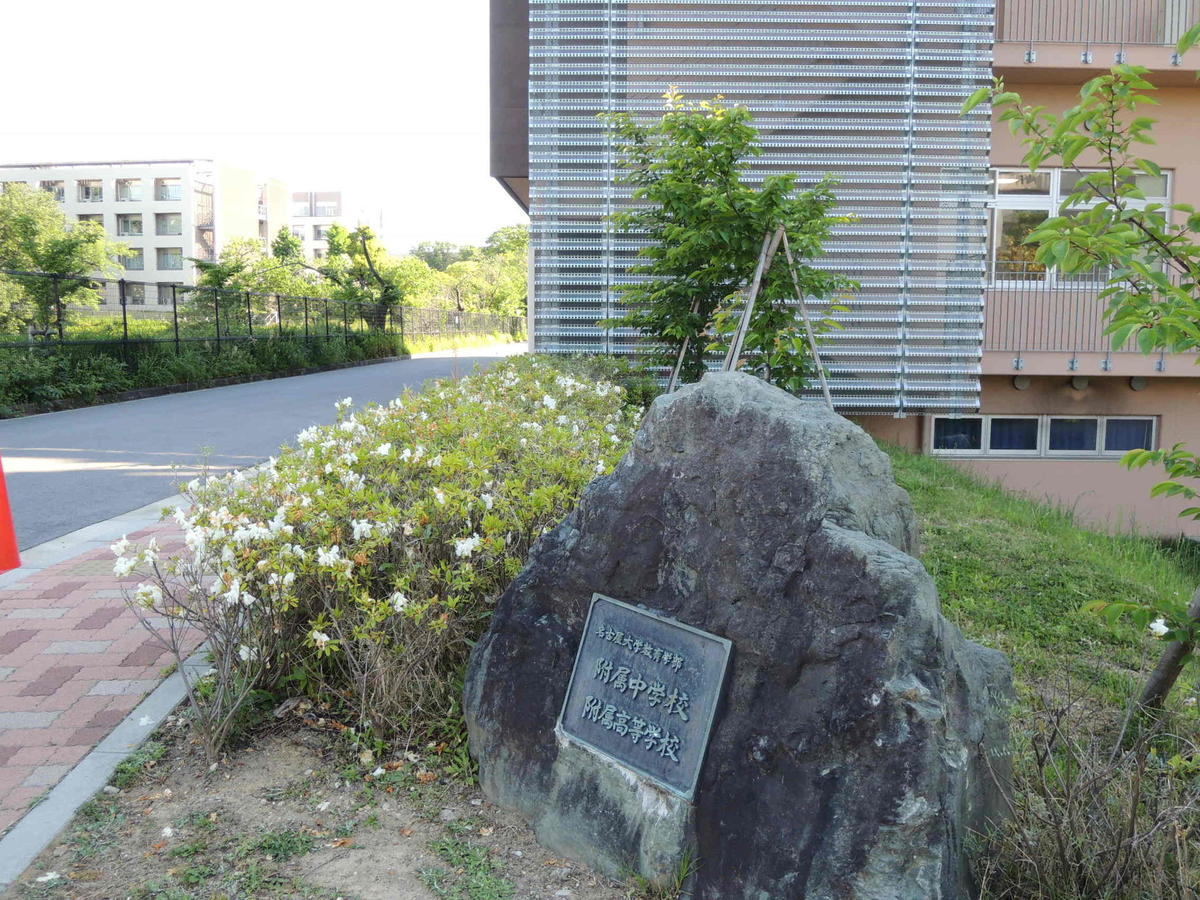One day at the end of May, high school students filled the Sakata & Hirata Hall of the School of Science. Among them were about 90 high school students from India, Nepal and Bhutan who had been invited to Japan for Sakura Science, the Japan-Asia Youth Exchange Program in Science, sponsored by the Japan Science and Technology Agency. The program brings high school students to Japan on exchange programs from Asia. Also present were about 120 grade ten high school students from the Nagoya University Affiliated Upper Secondary School. The Asian students stayed in Japan for about a week, listening to lectures from Nobel laureates, touring universities, having exchanges with Japanese high school students, and experiencing Japanese culture. The goal is to boost interest in Japanese science and technology through a variety of programs.
In the Hall, with Naoshi Sugiyama (Dean, School of Science) interviewing, Toshihide Maskawa (Nobel laureate for his work in theoretical physics) recounted his childhood memories and an interest in everything he saw and heard, reflecting upon his student days in Nagoya University as a time when he always debated with colleagues. Above all, he encouraged students to start out with aspirations and fascination. The students listened intently, and the hall was sometimes punctuated by laughter. They later separated into groups and socialized over lunch, then moved on to the affiliated secondary schools on campus to experience Japanese culture in the forms of Japanese harps, art of flower arrangement, traditional tea ceremony, and so on. For the participants these were undeniably special experiences.
It was slightly unfortunate that the Asian students did not have the opportunity to visit the research labs of Nagoya University, but I certainly hope that next time, participants will be able to visit these sites that Prof. Maskawa had said were so interesting. Among them are sure to be students who will aim to study at Nagoya University.
Actually, the Affiliated Upper Secondary School has exchange programs involving mutual home stays with high schools in countries like the US and Mongolia. While in Japan students from abroad had the opportunity to visit Nagoya University, and some of them are said to be planning to study here. Under the Sakura Science program about 1,000 high school students come to Japan each year. Hearing a lecture by a Nobel laureate is just the beginning of what they could do here.
 Students in group photo with Dr. Maskawa after lecture
Students in group photo with Dr. Maskawa after lecture
It is indisputable that there are enormous benefits of exposing curious young minds to a variety of experiences in new environments. The Nagoya University Affiliated Upper and Lower Secondary Schools offer a unique education thanks to their location inside a university, where students are in walking distance of lectures by Nobel laureates. Let me explain some examples of this.
Perhaps the special character of school is encapsulated in one of the school's slogans, "Discover yourself in the programs integrated with the university." Upper and middle secondary schools affiliated with a national university may give one the impression that they exist mainly to prepare students to enter famous universities. However, in this case the emphasis is not on training for university entrance exams but on the context of what each student wants to do and learn. The schools say that they emphasize offering an education for individuals that will help to find the future path that fits each person.
The programs mentioned here are conducted as a Super Science High School (SSH) and Super Global High School (SGH) designated by Japan's Ministry of Education, Culture, Sports, Science and Technology. Based on the idea that every person needs a good foundation in science, Meidai's affiliated schools (lower secondary school included) work on SSH program for all students. This is in contrast to the program at most high schools, where only a subset of students takes classes dedicated to science and math studies. Similarly, in SGH program, as a part of general humanities studies students at middle and high schools take the initiative to learn, think, and discuss themes of searching for ways to live, life and the environment, and international understanding and peace. As the school's slogan suggests, both programs include many lectures by Nagoya University professors and there is a strong connection with the university.
Sciences and arts programs are well-integrated in the SSH and SGH programs. As part of the SSH program, high school students attend seminars with a format that would be typical for Nagoya University's first-year students. Initially, some critics said this approach had no merit for Nagoya University. But looking more closely, it turned out that high school students who had experience in thinking about problems that do not necessarily have a correct answer (as we see in general humanities studies) were better at presenting interesting arguments than those students who had focused only on studying day and night for university entrance exams.
Sometimes kids from the daycare center built for Nagoya University staff come to play as part of childcare practicums in home economics classes at the school. High school students can interact with young children they would not normally have the chance to be with. For daycare kids, a visit to high school classes is an opportunity to be with the older children they see as their own future. "They learn from each other," says Junko Hara, vice principal of the high school. When you look closely, in the university environment you can certainly discover different opportunities to learn everywhere.
 Junko Hara, Vice Principal, Nagoya University School of Education Affiliated Upper Secondary School
Junko Hara, Vice Principal, Nagoya University School of Education Affiliated Upper Secondary School
The school values the learning of each and every student. In the background to this kind of education, there seems to be a tradition of internationally-renowned research at Nagoya University known as "lesson study." In lesson study, rather than an emphasis on how to TEACH, the emphasis is placed on how each and every student LEARNS, and school lessons are meticulously analyzed through careful observation of school lessons.
This kind of research on lessons originally started with an initiative by Takayasu Shigematsu, who created social studies as a new subject in the former Ministry of Education just after Second World War and transferred to Nagoya University as a professor in the School of Education later. His research was aimed at efforts toward democracy in education and the scientific approach, using careful observation to objectively evaluate the interactions in a lesson -- to look at how children really learn, rather than judging on authority of a teacher.
It takes a lot of time and energy to create precise records of observations of a lesson. "It was painstaking work but also academic, and we really persevered in our research," says Prof. Yoshiaki Shibata of the School of Education. The reward was international recognition. And in fact, an international conference on lesson studies will be held this fall at Nagoya University.
 The affiliate schools have no exterior gates, only a stone marker in front of the school building. Nagoya University's School of Engineering can be seen on the left in the background.
The affiliate schools have no exterior gates, only a stone marker in front of the school building. Nagoya University's School of Engineering can be seen on the left in the background.
There are about 600 pupils at the affiliated secondary schools. The schools are small but "free and vibrant," like another slogan of Nagoya University, and the students are like bold younger brothers and sisters. "We aim to provide high quality secondary education," says Takeo Ueda, dean of the School of Education, who also has six years of experience as school principal.
In the place we know as Nagoya University, middle and high school students are growing by learning each other with university people. I think that is a splendid thing. As research schools designated by the Ministry of Education, Culture, Sports, Science and Technology, these schools are expected to spread what they accomplished to other schools. School principal Tetsuhiko Nakajima is proud when he speaks about his ambitions: "In the future I would like more people outside to know what we do."
I too hope they will spread this excellent model of secondary education in which the individuality of every student is truly cherished.

 Subscribe to RSS
Subscribe to RSS